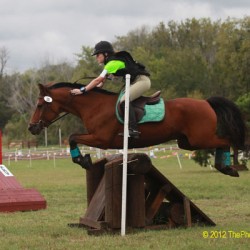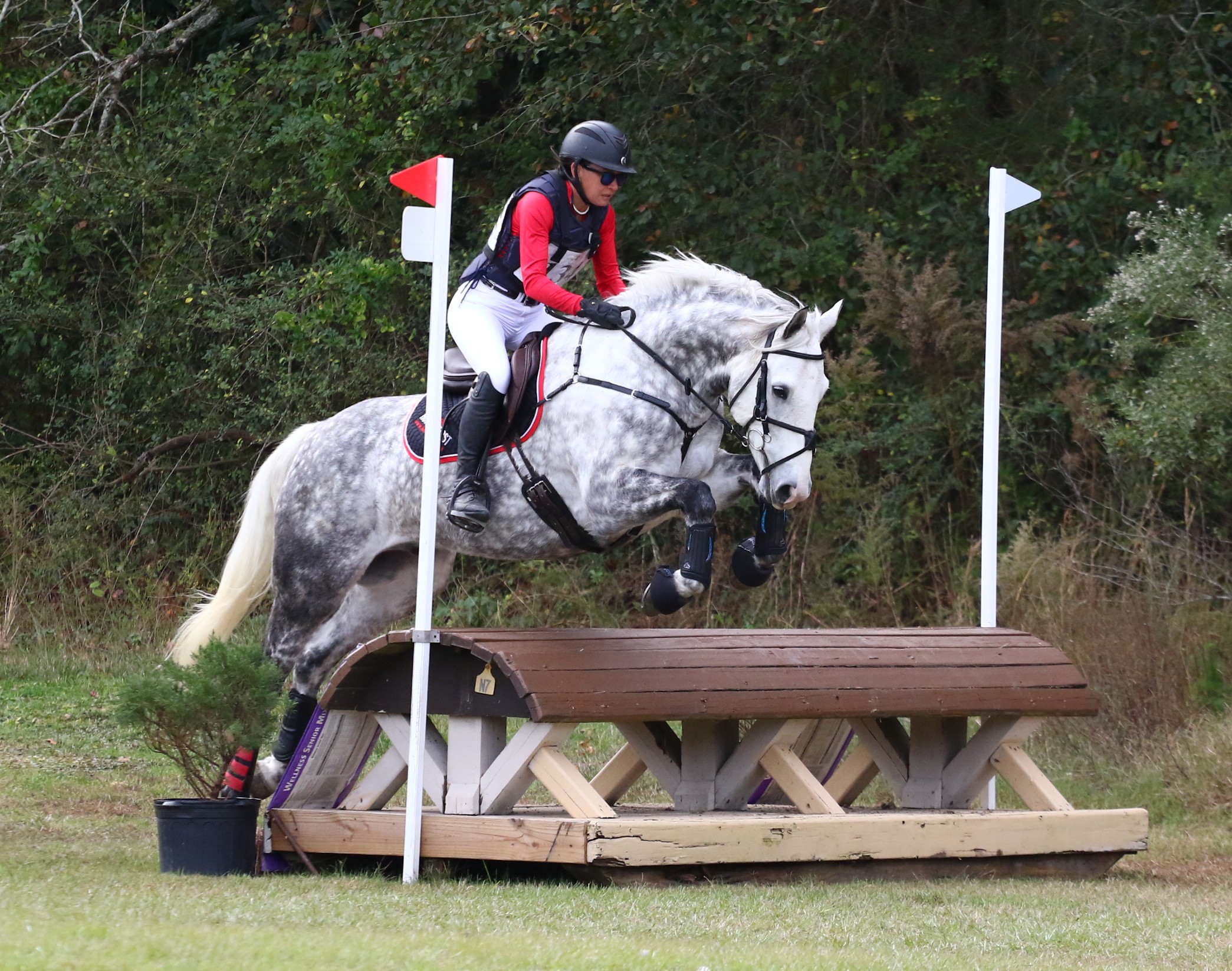MeadowCreek Park Horse Trials, Kosse, TX – The Rewards of Preparation and Fortitude
by Mary Hirsch

Mark Hall and Remington Steele Credit: Manuel Flores – A Photon Hunt
Robbie and Brad Peterson, owners of MeadowCreek Park in Kosse, Texas, host two Area V recognized horse trials each year. They made an enormous investment over the summer into bringing their grounds substantially up in quality, re-working the footing, re-designing and re-building the cross-country course, but they did not expect to be tested to the very limit by a relentless two-day rain storm at the very first horse trials after work was completed. Still after a weekend of schedule changes and minor course modifications, several riders, trainers and officials gave glowing reviews. Or in their words: “Fabulous job!” “Rode well, so much better than I thought after the rain.” And as Diane Pitts, Area V Young Rider Coordinator, texted to the Ground Jury, “MeadowCreek is back!”
Several inches of relentless rainfall saturated the MeadowCreek dressage and show jumping on Saturday, Sep. 29. It was a continuation of a downpour that had begun on Friday. Riders and attendees left the wet grounds on Saturday night full of suspense and debate – will we be able to run cross-country on Sunday, or will this horse trials become a combined test? What if it rains overnight? (It did.) At stake was a course that was the product of a great refurbishment, as well as competitors’ hopes of qualifying rounds, and even just a good and safe experience.
But among the event officials that question was never in doubt– MeadowCreek cross-country would run on Sunday. “Of course it rains on many events all over the country, all over the world. The decision to run or not to run isn’t a suspenseful drama. It’s a defined process,” explained Ground Jury President Jim Graham. “The first concern is safety, and that is broken down into specific components.”
“We had a Plan A, Plan B and a Plan C already formulated by Friday night. We ended up doing Plan Z, a combination of the plans,” Graham explained. The first part of Plan Z was re-arranging MeadowCreek’s traditional order of dressage and cross-country on Saturday, show-jumping on Sunday. “The first consideration for cross-country is if a critically injured horse and/or a rider can be evacuated quickly from the course.”
“Will a helicopter ambulance be able to fly in the weather conditions? Can the pilot see directions given from the ground, and will wind allow it to land? And the EMT’s and horse ambulance personnel assess if conditions will allow them to access the course to extract a rider or a horse over ground.” So, an all-day forecast of wind, along with the steady rain, led to the schedule change. Fortunately no lightning appeared either day.
And so on Saturday competitors soldiered on. Bays and chestnuts took on the same color – wet. Not every competitor chose to make the allowed switch to rain gear, and one can only imagine what the dry-cleaners will say when they receive the wadded bundles of thoroughly saturated, mud splattered show coats. One rider admitted that her high-quality, leak-proof boots filled from the top with rain. But the footing in both the dressage and the show jumping arenas, while deeper by the hour, responded to the work invested in it over the summer and remained largely stable. Horses were not seen to be slipping. While the Prelimimary and Training divisions saw many rails tumble, in all divisions there were also double-clear rides over the jumps in driving rain.
No report of MeadowCreek is complete without a word about the emphasis on hospitality. A Friday evening gathering and a Saturday evening social, with food, isn’t all. During the day one of the covered decks becomes the Man-Cave. Two wide-screen t.v.’s broadcast football games to the couches next to the vending machines. Dads, husbands, SO’s across the Nation of Eventers: You could have been at MeadowCreek!
“On Saturday evening we assured competitors we would run cross-country on Sunday,” Graham said. The decision was made on a drier forecast for Sunday, even though more rain came through overnight. “Saturday evening and very early Sunday morning the officials were out on course. We removed only a couple of jumps from Preliminary and Training, and moved just a few others. We made no changes to the Novice and Beginner Novice courses.”
It was a gray early morning as riders and attendees gathered at 7:30 a.m. on Sunday in MeadowCreek’s large covered porch area for an official meeting about the cross-country course. There officials affirmed once again that cross-country would run, “with flexible start times.” The first to go, Preliminary and Training, were asked, along with their trainers, to join course tours by 4-wheelers to view the slightly modified course. Competitors in all divisions were encouraged to catch a ride at some point to review conditions on their course as well.
“We listened to the riders’ and trainers’ comments,” said Graham, “and made a few other moves of upper-level obstacles, and removed one more jump. We didn’t make all the suggested changes, but we did consider the merits of each.” Finally all preparations were complete. Under an overcast, windy but rain-less sky, at last horses began to emerge from the tall trees surrounding the stabling area with all gear on and riders aboard, in a steady parade to warm-up. Shortly after 10:30 a.m. horses were on course, and things were rolling once again.
Riders and trainers reported the courses rode well. There were few jumping faults across all divisions. The new courses travel from one meadow to the next through connecting tree-shaded trails, with a variety of obstacles and questions. Courses are up to height, but as one trainer said, “that doesn’t matter because it flows.” The Preliminary course has added galloping jumps around a large green meadow, then through the woods and up-and-down terrain jumps, finally routing back into the ditch complex.
As is usual at any event with a lot of rain, in some divisions most of the riders chose to complete; in others, most riders did not. As always the reasons were varied: concerns about shoeing and/or studding; horse or rider green at the level; and the other usual reasons. And it may have been a factor that Area V has four more recognized events to run before the fall season closes out in November.
Preliminary cross-country riders all had quite a few time faults, but only one rider had jumping faults. The three riders completing Open Preliminary all took advantage of withdrawals to come up from double-digit placings. Open Prelim winner Emily Dufort and Vital Eight came from 10th place after show jumping. In the Preliminary Rider division, Morgan Worthington and Primo’s Charro were the only pair in all Prelim to come in with under ten time faults, and that allowed her to edge out Bailey Moran and Corocotta de la Galerna for the win.
Training had several double-clears across all three divisions. Open Training offered a shrewd opportunity when the top five placings after show jumping elected to withdraw. Amanda Merritt on Flagmount’s Mischief, 8th after show jumping, won on a 33.2 dressage score, while Ashley Hays and Northern Lights, 10th after show jumping, came in right behind her for second place, adding nothing to her 35.2 dressage score. For all the rest of the divisions at MeadowCreek, clean jumping and zero time faults claimed the top placings, with the exception of minimal time faults with clear jumping in Beginner Novice.
“As long as emergency services can be accommodated and there is no lightening, a well-prepared cross-country course can expect to run with only a few modifications that don’t change the intent of the design,” Jim Graham asserted.
“This course is national caliber. It is a tribute to the hard work and dedication of Robbie and Brad Peterson. We can look forward to quality courses and horse trials in the future.”
-

-

-

-
Photo by Manuel Flores
-

-
Photo by Manuel Flores – A Photon Hunt
-

-
Photo by Manuel Flores – A Photon Hunt
-

-
Photo by Manuel Flores – A Photon Hunt
-

-

-

-

-

-

-

-

-

-

-

-

-

-
photo by Manuel Flores – A Photon Hunt
























































































